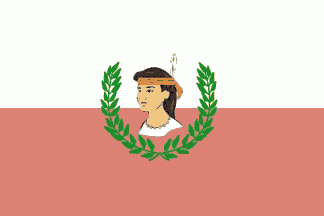
by Carlos Thompson, 21 December 2004

Last modified: 2004-12-22 by dov gutterman
Keywords: cundinamarca | guayabal de siquima | siquima | guava |
Links: FOTW homepage |
search |
disclaimer and copyright |
write us |
mirrors

by Carlos Thompson, 21 December 2004
See also:
The flag of Guayabal de Síquima. Only this municipality and Guayabetal have a "guava"
color in its flags. The "guava" is a light red, in RGB
scale is 255-96-96. In spanish it means "guayaba" and
is a fruit of hot and medium weathers.
Jairo Alonso Méndez Méndez, 16 April 2004
Both the tree and the edible fruit are called
"guava" in English. In French and Dutch, the difference
between the tree and the fruit is expressed ("goyavier"
and "goyave", "guaveboom" and
"guave", respectively).
"Guava" is the name given to the fruit by the Caribbean
natives. The Spaniards transformed it in to "guayaba",
which gave the French "goyave" via "goulave".
The guava (Psidium guyava) belongs to genus Psidium, family
Myrtaceae, order Myrtales. The members of the Myrtaceae are
aromatical trees or shrubs. Most of them are tropical, except the
myrtle (Myrtus communis) which has survived in the Mediterranean
areas. Among the Myrtales of economical interest are the clove
tree (Syzygium aromaticum), the niauli tree (Melaleuca
virdiflora), the all-spice tree (Pimenia acris), and the
Eucalyptus. There is in Africa a wild tree whose non-edible fruit
look like guavas, called "goyavier de brousse" (brush
guava).
Sources: Grand Robert de la Langue Francaise;
Encyclopaedia Universalis.
Ivan Sache, 17 April 2004
From <www.cundinamarca.gov.co>:
"Forma rectangular, dividida en dos franjas horizontales, en
la misma proporción. Sus colores hacen alusión al origen del
nombre del municipio.
El color superior blanco, es la paz que anhelan los habitantes de
este municipio, de esta patria y del mundo.
El inferior es de color guayaba, representa la región que
antiguamente era una gran hacienda muy rica en la producción de
esta fruta. En el centro una corona de hojas con un rostro
indígena Panche en homenaje a ese guerrero que se llamó
Síquima, cuya palabra es la segunda parte del nombre del
municipio."
Felipe Carrillo, 20 November 2004
cungs.jpg)
from <www.cundinamarca.gov.co>